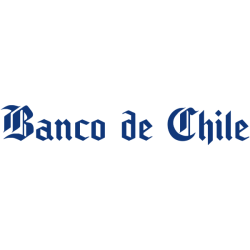
FMP

Banco de Chile
BCH
NYSE
Banco de Chile, together with its subsidiaries, provides banking and financial products and services to customers in Chile. It operates through Retail Banking, Wholesale Banking, and Treasury and Money Market segments. The company offers deposit products, such as checking accounts, current accounts, demand deposits and accounts, saving accounts, and time deposits; commercial, mortgage, consumer, working capital, syndicated, and installment loans; and credit cards. It also provides leasing, factoring, and foreign trade services; international and treasury banking services; and financial advisory services. In addition, the company offers liquidity management services, debt instruments, and derivative contracts and leases, as well as financial transaction and currency trading services; and securities brokerage, mutual funds management, wholesale customer, investment banking and management, and insurance brokerage services. As of December 31, 2021, it operated through a network of 272 branches and 1,761 ATMs. The company serves individuals, small and medium-sized companies, corporate clients, and large companies. Banco de Chile was founded in 1893 and is headquartered in Santiago, Chile.
21.96 USD
-0.09 (-0.41%)
DuPont Analysis
The DuPont analysis, pioneered by the DuPont Corporation, offers a structured approach to assessing fundamental performance. It involves breaking down the return on equity (ROE) into various components, aiding investors in comprehending the factors influencing a company's returns.
ROE = Net Income / Average Total Equity
ROE = (Net Income / Sales) * (Revenue / Average Total Assets) * (Average Total Assets / Average Total Equity)
The company's tax burden is (Net income ÷ Pretax profit). This is the proportion of the company's profits retained after paying income taxes. [NI/EBT] The company's interest burden is (Pretax income ÷ EBIT). This will be 1.00 for a firm with no debt or financial leverage. [EBT/EBIT] The company's operating income margin or return on sales (ROS) is (EBIT ÷ Revenue). This is the operating income per dollar of sales. [EBIT/Revenue] The company's asset turnover (ATO) is (Revenue ÷ Average Total Assets). The company's equity multiplier is (Average Total Assets ÷ Average Total Equity). This is a measure of financial leverage. Profitability (measured by profit margin) Asset efficiency (measured by asset turnover) Financial leverage (measured by equity multiplier)